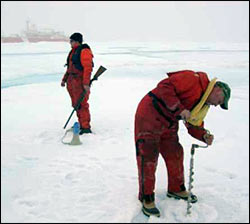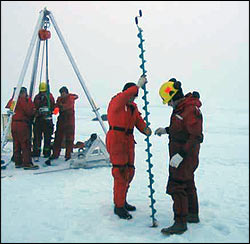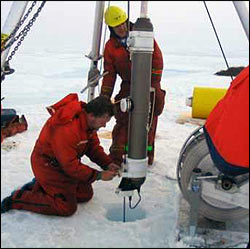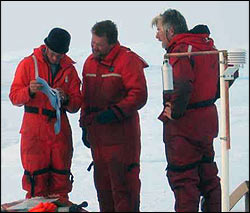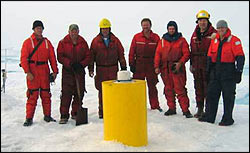Please note: You are viewing
the unstyled version of this website. Either your browser does not support CSS
(cascading style sheets) or it has been disabled. Skip
navigation.
Rick KrishfieldAugust 22, 2004
The IMB measures properties of the surface atmosphere and ice floe that it is situated in, using an air temperature monitor, barometric pressure sensor, ice thermistor strings, a snow depth sensor, and an upward looking sonar. Primarily, the IMB is designed to monitor the growth and ablation of sea ice. The ITP is designed to autonomously acquire profiles of the temperature and salinity of the upper ocean from 10 to 800 m for several years, to understand the state and variability of the upper Arctic Ocean under sea ice through all seasons. Both the IMB and ITP transmit their data (and locations) back to their respective laboratories via satellites. For this experiment, one of each buoy type are to be deployed together on the same icefloe to obtain concurrent data while drifting with the sea ice around the Beaufort Gyre. On August 18, while we are heading east roughly around 77.5 deg N, several of us are discussing ice conditions and operations for deploying the ITP with Captain Andrew McNeill and the ice observer, Dan Crosbie. Unable to fly the helicopter to look for an appropriate deployment site due to fog, we are looking for a good old floe on the way. After dinner, one is spotted, and John Kemp and myself hop on the helicopter, with Pilot Joe Fraser, and Seaman Andrew Kaiser to carry the rifle. We intend to survey the floe, and if the ice is good, we will deploy immediately. The ice ends up being almost too good. It is a hard old floe, and takes us a long time to drill with the 2" diameter hand auger. After drilling 4 m, we think that we are almost to the end, but don't have enough extensions. Not willing to give up on this floe, another site is selected, and there we penetrate the ice cover after only about 3.75 m. So the decision is made to go ahead with the deployment there. However, since it is late in the evening by the time we return, the deployment begins on the following day. Up the next morning at 5:30, on the helicopter deck by 6 AM, and on the ice by 6:15 to deploy the ITP and IMB buoys. Although it was pretty foggy in the morning and visibility was limited, 8 of us were transferred to the ice in three flights (plus gear) for the operations. There were also two slingloads of cargo. Cutting the 11" diameter hole in the ice was the hardest part of the ITP deployment. Cutting through the 4 m of old hard ice progressed reasonably well until we got past the halfway point. Then water turned the ice shavings into slush, and the auger flutes couldn't remove the material. So the going got very difficult. We tried using four people (instead of the normal two) on the auger, but that still didn't produce results. It helped considerably to set up the tripod and hang the auger from a chainfall, so that we could drill at a controlled rate. When the hole was cut, the anchor weight and wire were smoothly deployed, then the ITP profiler was attached to the wire. Simultaneously, the IMB was being assembled and installed. Cutting the holes for the IMB was much easier since the 4" diameter drill could be used. After 4 hours, both systems were deployed, and everyone was safely transported back to ship by helicopter. Not only was it fulfilling to accomplish the deployment of the buoys, but it was also fun (as always) to walk again on the sea ice.
Last updated: October 7, 2019 | ||||||||||||||||||||||
Copyright ©2007 Woods Hole Oceanographic Institution, All Rights Reserved, Privacy Policy. | ||||||||||||||||||||||


